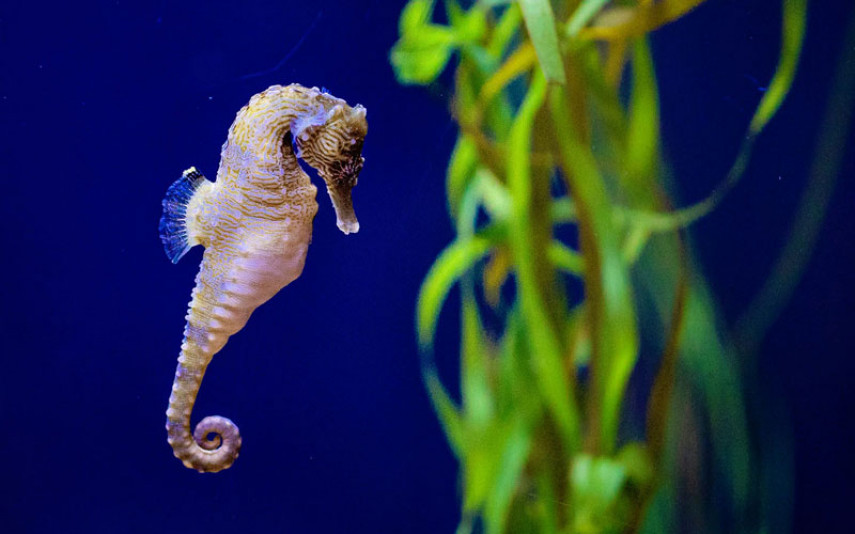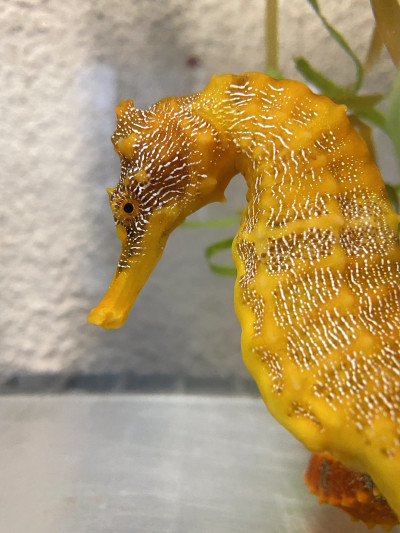This World Ocean Month, we wanted to highlight the important work of the International Union for the Conservation of Nature (IUCN) Species Survival Commission (SSC) Seahorse, Pipefish & Seadragon Specialist Group. This group serves as a leader in protecting and conserving seahorses, pipefishes, seadragons, and their relatives worldwide!
Today, 41 members from 22 countries across the globe make up this conservation group — including Leslee Matsushige, an Associate Curator at Birch Aquarium at Scripps. Leslee has worked with seahorses, pipefish, and seadragons at Birch Aquarium for close to 30 years and serves as a leader in our seahorse and seadragon breeding programs.
Our seahorse and seadragon breeding efforts raise awareness of animals facing extinction and support our programs like Species Survival Plans. This work is also incredibly valuable to scientists and conservation groups — like IUCN SSC SG — trying to learn more about these fish and how to protect them!
Communities Conserving Charismatic Creatures
Seahorses are fairly elusive creatures — their small size and stealth combined with expert camouflage, make population counts challenging even for the most experienced seahorse spotter! So determining the conservation status of seahorse species in the wild is especially challenging. One of the major goals of IUCN SSC SG is to obtain more accurate seahorse population counts to better protect them. This is where YOU come in!

Did you know there are a few community science projects that focus on documenting seahorse sightings in the wild? Community science is a global movement that enables anyone to explore our natural world and simultaneously contribute to science — no science background necessary!
One organization IUCN SSC SG works closely with is Project Seahorse and their community science project iSeahorse — a project under the iNaturalist platform that’s focused on recording seahorse specific observations. The goal of iSeahorse is to provide a public platform to document seahorse sightings in the wild to improve our understanding of these animals and protect them from overfishing and other threats.
Want to participate in iSeahorse? If you ever spot a seahorse in the wild you can upload your own photos of seahorses you see in the wild to the iSeahorse project within the iNaturalist platform! Not sure what kind of seahorse you saw? No worries. iSeahorse offers suggestions or other community members can help you ID the animal — you can also look at the observations of your fellow community scientists to help each other identify which species you've seen.
To date, Project Seahorse has received over 8000 observations from more than 1400 community scientists. These observations have provided scientists with crucial information about where seahorses are found that help inform seahorse conservation policies. Some of these findings have even led to major conservation efforts — including the creation of a new Marine Protected Area (MPA) in the village of Anda, Bohol, Philippines that protects crucial habitat for local seahorse species!
A Seahorse in San Diego?
You might be wondering … how can I help in Southern California? Well, did you know a species of seahorse can be found here in San Diego? The Pacific Seahorse is found along the coast from Southern California all the way south towards Peru — this species has been spotted locally in San Diego’s protected bays and estuaries.

This gentle giant is one of the largest species of seahorse and can get up to 12 inches long — that’s about the size of a toothbrush. They’re primarily active at night and during dawn and dusk so if you’re going for a snorkel or SCUBA dive at this time you may be able to spot them! This seahorse typically hangs out around seagrass beds and harbor areas — you can even sometimes spot them on ropes or anchor lines.
Pacific Seahorses face many risks from overfishing and habitat loss. A destructive fishing method known as bottom trawling is responsible for many accidental catches of Pacific Seahorses. Trawling involves pulling a large net across the bottom of the ocean floor and is a common method for shrimp fishing. There is no way to select which species you want to catch while trawling — so many seahorses are often scooped up in the process. This unsustainable fishing practice damages seahorse habitats, further threatening wild populations!
Fortunately, community science efforts — like iSeahorse — are helping scientists obtain a better understanding of current Pacific Seahorse population levels and how far their habitat range extends. With this information, scientists can create more effective policies that limit or prohibit Pacific Seahorse capture and prevent trawling and other damaging practices within protected areas of seahorse habitat.
Pacific Seahorses are currently listed as vulnerable to extinction by the IUCN Red List (check-out our recent endangered species blog to learn more) which means it’s crucial to act now to conserve and protect this species! By participating in the community science effort you can actively help scientists monitor Pacific Seahorse population numbers and identify critical habitat to protect.